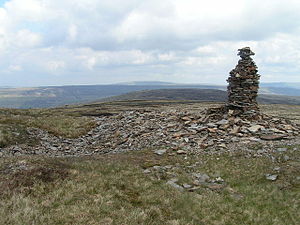Fountains Fell
| Fountains Fell | |||
| Yorkshire | |||
|---|---|---|---|
 Cairn on Fountains Fell | |||
| Range: | Yorkshire Dales | ||
| Summit: | 2,192 feet SD864715 54°8’23"N, 2°12’34"W | ||
Fountains Fell is a mountain of 2,192 feet in the West Riding of Yorkshire, amongst the Yorkshire Dales.
Between the two main peaks of he fell lies Fountains Fell Tarn.
The main summit, at 2,192 feet is listed as a 'Marilyn',[1] and its subsidiary, Fountains Fell South Top (SD868708) reaches 2,172 feet, and qualifies as a 'Nuttall'.[2] A third summit, further south at SD868697, reaches 2,001 feet, and is reckoned the most southerly 2,000-foot summit in the Yorkshire Pennines.[3]
The eastern slopes of the fell form part of the National Trust's Malham Tarn and Moor estate.[4]
History
The name Fountains derives from ownership of the land in the 13th century by the Cistercian monks of Fountains Abbey (25 miles to the east, near Ripon), who used it for sheep grazing.[5] Coal was mined on the summit from 1790 to 1860, and was used for lead smelting in the area.[5] There are various pits and shafts on and near the summit, and the remains of a coke oven building.[5]
Pennine Way
The Pennine Way crosses Fountains Fell about a third of a mile north of the summit. For the northbound walker this is 85 miles from the southern start of the way at Edale in Derbyshire and is the first point where the way climbs higher than Kinder Scout's 2,087 feet, which was reached soon after the start. It is eight miles along the Pennine Way from Malham village to the summit of Fountains Fell, the route climbing up beside the dramatic cliffs of Malham Cove and passing Malham Tarn before climbing up the east side of the fell.
The route continues down the western slopes of the fell and ascends the southern ridge of Pen-y-ghent, reached after three and a half miles: this summit of 2,277 feet then supplants Fountains Fell as the highest point yet reached on the Pennine Way.[6]
Caving
There are several caves of interest to cavers on Fountains Fell, including Antler Hole, Dalehead Pot, Echo Hole, Fornagh Gill, Gingling Pot, Hammer Pot and Magnetometer Pot.[7]
Outside links
| ("Wikimedia Commons" has material about Fountains Fell) |
References
- ↑ Dawson, Alan (1997). "Section 35B: Central Pennines". TACit Tables: The Hewitts and Marilyns of England. TACit Press. ISBN 0-9522680-7-8. http://bubl.ac.uk/org/tacit/tables/england/marreg35.htm. Retrieved 2008-05-25.
- ↑ Nuttall, John; Nuttall, Anne. "Mountains of England". http://www.nuttalls.com/mountains/england.htm.
- ↑ Wright, Nick (1974). English Mountain Summits. London: Robert Hale. p. 68. ISBN 0-7091-4560-8.
- ↑ National Trust. "Malham Tarn and Moor". http://www.nationaltrust.org.uk/main/w-vh/w-visits/w-findaplace/w-malhamtarnmoor.htm.
- ↑ 5.0 5.1 5.2 Nuttall, John; Nuttall, Anne (1990). The Mountains of England and Wales. Cicerone Press. p. 276. ISBN 1-85284-037-4. https://books.google.com/books?id=-c_CyZOz_24C&dq=fountains+fell+coal&pg=PA276. Retrieved 2008-05-25.
- ↑ Wainwright, Alfred (1968). Pennine Way Companion. Westmorland Gazette ltd. pp. 111–119.
- ↑ Council of Northern Caving Clubs. "Caving Access: Three Peaks Area". http://www.cncc.org.uk/access/caves.php?marea=2.